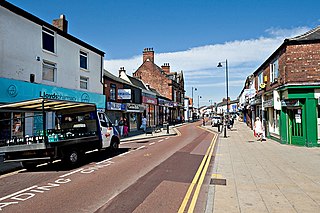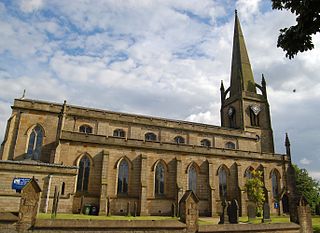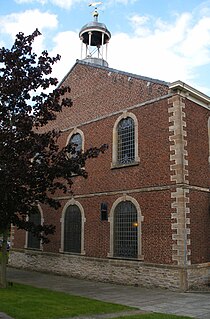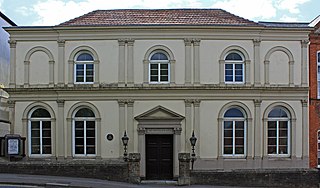The General Assembly of Unitarian and Free Christian Churches is the umbrella organisation for Unitarian, Free Christians, and other liberal religious congregations in the United Kingdom and Ireland. It was formed in 1928, with denominational roots going back to the Great Ejection of 1662. Its headquarters is Essex Hall in central London, on the site of the first avowedly Unitarian chapel in England, set up in 1774.

Toxteth Unitarian Chapel is in Park Road, Dingle, Liverpool, Merseyside, England. Since the 1830s it has been known as The Ancient Chapel of Toxteth. It is recorded in the National Heritage List for England as a designated Grade I listed building. and continues to be in use as a Unitarian chapel. It is a member of the General Assembly of Unitarian and Free Christian Churches, the umbrella organisation for British Unitarians.

Ullet Road Church is a Unitarian church at 57 Ullet Road, Sefton Park, Liverpool. Both the church and its attached hall are separately recorded in the National Heritage List for England as designated Grade I listed buildings. It was the first place of worship in the United Kingdom to register a civil partnership for a same-sex couple. It is a member of the General Assembly of Unitarian and Free Christian Churches, the umbrella organisation for British Unitarians.

Atherton is a town in the Metropolitan Borough of Wigan, in Greater Manchester, England and historically a part of Lancashire. The town, including Hindsford, Howe Bridge and Hag Fold, is 5 miles (8.0 km) east of Wigan, 2 miles (3.2 km) north of Leigh, and 10+3⁄4 miles (17.3 km) northwest of Manchester. From the 17th century, for about 300 years, Atherton was known as Chowbent, which was frequently shortened to Bent, the town's old nickname.

Dean Row Chapel is a Unitarian place of worship in Cheshire, North West England. It is located 2 miles (3 km) east of the town of Wilmslow, Cheshire, near the junction of the A5102 and B5358 roads. The structure is recorded in the National Heritage List for England as a designated Grade II* listed building. The congregation is a member of the General Assembly of Unitarian and Free Christian Churches, the umbrella organisation for British Unitarians.

Caleb Wright was an English mill owner and Liberal politician in Lancashire, north-west England.

St George's Church is an Anglican parish church serving Tyldesley and Shakerley in Greater Manchester, England. It is part of Leigh deanery in the archdeaconry of Salford and the diocese of Manchester. The church, together with St Stephen's Church, Astley and St John's Church, Mosley Common is part of the united benefice of Astley, Tyldesley and Mosley Common.

The Parish Church of St Mary the Virgin is a Church of England parish church in Leigh, Greater Manchester, England. It is a member of the Salford & Leigh deanery in the archdeaconry of Salford, diocese of Manchester. It is recorded in the National Heritage List for England as a designated Grade II* listed building.

St John the Baptist's Church is in Market Place, Atherton, Greater Manchester, England. It is an active Anglican parish church in the Leigh deanery in the archdeaconry of Salford, and diocese of Manchester. Together with St George's and St Philip's Churches in Atherton and St Michael and All Angels at Howe Bridge, the church is part of the United Benefice of Atherton and Hindsford with Howe Bridge. It is recorded in the National Heritage List for England as a designated Grade II listed building.

James Wood (1672–1759) was a Presbyterian minister of the first Atherton and Chowbent Chapels in Atherton, Greater Manchester, England. During the Jacobite rising, he was given the title "the General" for leading a force of men that routed the Highlanders.

Howe Bridge is a suburb of Atherton, Greater Manchester, England. Historically within Lancashire, it is situated to the south west of Atherton town centre on the B5215, the old turnpike road from Bolton to Leigh. The settlement was built as a model pit village by the owners of Atherton Collieries.

Billingshurst Unitarian Chapel is a place of worship in Billingshurst in the English county of West Sussex. The cottage-like building was erected in 1754 for General Baptists, hence its original name of the Billingshurst General Baptist Chapel, but the congregation moved towards Unitarian beliefs in the 19th century, and still maintain these. It is a member of General Assembly of Unitarian and Free Christian Churches, the umbrella body for British Unitarians.

St Michael and All Angels' Church is in Leigh Road, Howe Bridge, a suburb of Atherton, Greater Manchester, England. It is an active Anglican parish church in the deanery of Leigh, the archdeaconry of Salford and the diocese of Manchester. Its benefice is united with those of three local churches, St John the Baptist, St George and St Philip, forming a team ministry entitled the United Benefice of Atherton and Hindsford with Howe Bridge. The church is recorded in the National Heritage List for England as a designated Grade II* listed building.

Sacred Heart Church is a Grade II listed redundant Roman Catholic church on Tyldesley Road, Hindsford, Atherton in Greater Manchester, England. It has been designated by English Heritage as a Grade II listed building.

St Joseph's Church is an active Roman Catholic church on Chapel Street in Bedford, Leigh in Greater Manchester, England. It is in the parish of St Edmund Arrowsmith. It has been designated by English Heritage as a Grade II listed building.

Christ Church is an active Anglican parish church in Pennington, Leigh, Greater Manchester, England. Christ Church serves the parish of Pennington in the Leigh Deanery and Salford Archdeaconry in the Diocese of Manchester. It is a Grade II listed building.

Taunton Unitarian Chapel is on Mary Street, Taunton, Somerset, England. It was built in the early 18th century as a Baptist chapel, but later adopted Unitarianism. The exterior was extensively renovated in the 19th century in an Italianate style. The chapel has been designated as a Grade II* listed building.
Atherton is a town in the Metropolitan Borough of Wigan, Greater Manchester, England. The town and its suburbs of Howe Bridge and Hindsford contain 17 listed buildings that are recorded in the National Heritage List for England. Of these, four are listed at Grade II*, the middle of the three grades, and the others are at Grade II, the lowest grade.


















